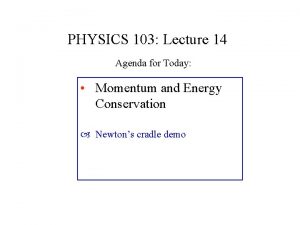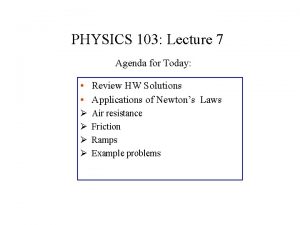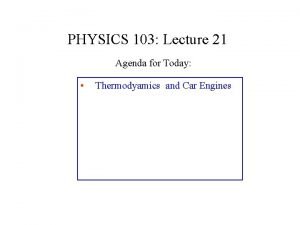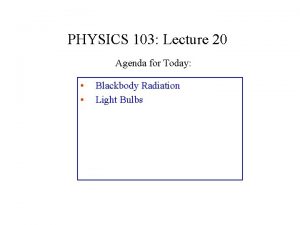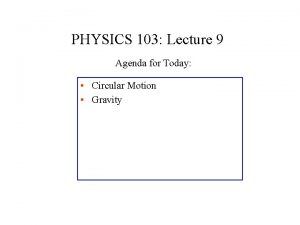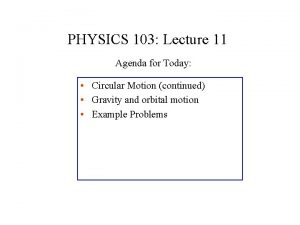PHYSICS 103 Lecture 3 Agenda for Today Motion












- Slides: 12

PHYSICS 103: Lecture 3 Agenda for Today: • Motion under uniform acceleration • Freely falling objects ç Acceleration due to gravity ç Tracking a falling object

Description of Motion with Uniform Accleration Remember from last class that acceleration is: If a is constant: Where: v = final velocity v 0 = initial velocity

Example of Uniform Accleration: A car accelerates at 3 m/s 2 from rest. What is the final velocity after 20 seconds? We know: v 0=0 m/s a=3 m/s 2 How far did it travel in this time? t=20 s

Remember from last class that distance is: If acceleration, a, is constant, then the final velocity, v, is given by: so:

Motion with Uniform Acceleration When an object accelerates at a constant rate the following applies: v= vo + at Final velocity acceleration Initial velocity: velocity at t = 0 d = d 0 + v 0 t + 1/2 at 2 Initial distance at t = 0 Initial velocity: velocity at t = 0 acceleration

Example Problems for Uniform Accleration: 1) A car starts out at a velocity of 2 m/s. If it's acceleration is 3 m/s 2, how fast will it be going in 20 s? 2) A car starts out at a velocity of 2 m/s. If it's acceleration is 3 m/s 2, how long will it take before it will be going 62 m/s 3) In the problem above, how far will it have traveled? 4)A car starts out at a velocity of 2 m/s. If its acceleration is 3 m/s 2, how long will it take the car to travel 640 m?

Freely falling objects Observations: 1) Heavy objects and light objects fall at the same rate with no air resistance 2) Things fall faster and faster until they hit the ground (acceleration)

Acceleration due to Gravity Free-fall is an example of motion with uniform acceleration

A ball is dropped from a a tall building. How long does it take to reach the ground? How fast is it going? where h = 1224 ft = 373 m to 102 nd floor initial final

Example of free-fall: v= vo + at d = d 0 + v 0 t + 1/2 at 2 d=373 m 0 d 0=0 m v 0=0 m/s 0 initial v= vo + at = 0 + (10 m/s 2)(8. 64 s) = 86. 4 m/s = 86. 4 m/s (1/1000 km/m)(1/1. 61 mile/km)(3600 s/hr) final = 193 mph

Main Points from Today’s Lecture • Motion with Uniform (Constant) Acceleration v= vo + at acceleration Final velocity Initial velocity: velocity at t = 0 d = d 0 + v 0 t + 1/2 at 2 acceleration Initial distance at t = 0 Initial velocity: velocity at t = 0 • Free fall ® How long does it take to drop things ® How fast are they going at any given time?

HW Re-Read Ch 3 Make sure you understand all example problems done in class
 01:640:244 lecture notes - lecture 15: plat, idah, farad
01:640:244 lecture notes - lecture 15: plat, idah, farad Agenda sistemica y agenda institucional
Agenda sistemica y agenda institucional Agenda for today
Agenda for today Today meeting or today's meeting
Today meeting or today's meeting Do we have class today
Do we have class today Meeting objective
Meeting objective Characteristic of fingerprint
Characteristic of fingerprint Today's lesson or today lesson
Today's lesson or today lesson Today's lesson or today lesson
Today's lesson or today lesson Physics 111 lecture notes
Physics 111 lecture notes Physics 101 lecture notes pdf
Physics 101 lecture notes pdf Phy101 lecture 1
Phy101 lecture 1 Physics 101 lecture notes pdf
Physics 101 lecture notes pdf
















